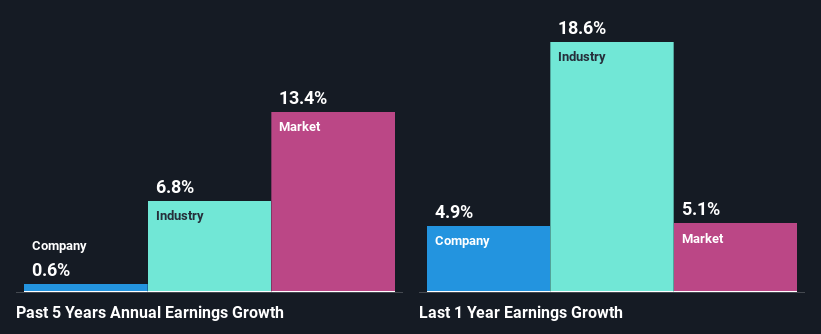Is Hap Seng Consolidated Berhad's (KLSE:HAPSENG) Stock Price Struggling As A Result Of Its Mixed Financials?
With its stock down 2.2% over the past month, it is easy to disregard Hap Seng Consolidated Berhad (KLSE:HAPSENG). We, however decided to study the company's financials to determine if they have got anything to do with the price decline. Long-term fundamentals are usually what drive market outcomes, so it's worth paying close attention. Specifically, we decided to study Hap Seng Consolidated Berhad's ROE in this article.
Return on Equity or ROE is a test of how effectively a company is growing its value and managing investors’ money. Put another way, it reveals the company's success at turning shareholder investments into profits.
See our latest analysis for Hap Seng Consolidated Berhad
How Is ROE Calculated?
The formula for ROE is:
Return on Equity = Net Profit (from continuing operations) ÷ Shareholders' Equity
So, based on the above formula, the ROE for Hap Seng Consolidated Berhad is:
11% = RM992m ÷ RM9.4b (Based on the trailing twelve months to March 2024).
The 'return' is the yearly profit. So, this means that for every MYR1 of its shareholder's investments, the company generates a profit of MYR0.11.
Why Is ROE Important For Earnings Growth?
Thus far, we have learned that ROE measures how efficiently a company is generating its profits. Depending on how much of these profits the company reinvests or "retains", and how effectively it does so, we are then able to assess a company’s earnings growth potential. Generally speaking, other things being equal, firms with a high return on equity and profit retention, have a higher growth rate than firms that don’t share these attributes.
A Side By Side comparison of Hap Seng Consolidated Berhad's Earnings Growth And 11% ROE
At first glance, Hap Seng Consolidated Berhad's ROE doesn't look very promising. However, the fact that the company's ROE is higher than the average industry ROE of 7.9%, is definitely interesting. Still, Hap Seng Consolidated Berhad has seen a flat net income growth over the past five years. Remember, the company's ROE is a bit low to begin with, just that it is higher than the industry average. So that could be one of the factors that are causing earnings growth to stay flat.
We then compared Hap Seng Consolidated Berhad's net income growth with the industry and found that the company's growth figure is lower than the average industry growth rate of 6.8% in the same 5-year period, which is a bit concerning.
The basis for attaching value to a company is, to a great extent, tied to its earnings growth. It’s important for an investor to know whether the market has priced in the company's expected earnings growth (or decline). Doing so will help them establish if the stock's future looks promising or ominous. One good indicator of expected earnings growth is the P/E ratio which determines the price the market is willing to pay for a stock based on its earnings prospects. So, you may want to check if Hap Seng Consolidated Berhad is trading on a high P/E or a low P/E, relative to its industry.
Is Hap Seng Consolidated Berhad Making Efficient Use Of Its Profits?
The high three-year median payout ratio of 81% (meaning, the company retains only 19% of profits) for Hap Seng Consolidated Berhad suggests that the company's earnings growth was miniscule as a result of paying out a majority of its earnings.
Additionally, Hap Seng Consolidated Berhad has paid dividends over a period of at least ten years, which means that the company's management is determined to pay dividends even if it means little to no earnings growth.
Summary
Overall, we have mixed feelings about Hap Seng Consolidated Berhad. On the one hand, the company does have a decent rate of return, however, its earnings growth number is quite disappointing and as discussed earlier, the low retained earnings is hampering the growth. Up till now, we've only made a short study of the company's growth data. To gain further insights into Hap Seng Consolidated Berhad's past profit growth, check out this visualization of past earnings, revenue and cash flows.
Have feedback on this article? Concerned about the content? Get in touch with us directly. Alternatively, email editorial-team (at) simplywallst.com.
This article by Simply Wall St is general in nature. We provide commentary based on historical data and analyst forecasts only using an unbiased methodology and our articles are not intended to be financial advice. It does not constitute a recommendation to buy or sell any stock, and does not take account of your objectives, or your financial situation. We aim to bring you long-term focused analysis driven by fundamental data. Note that our analysis may not factor in the latest price-sensitive company announcements or qualitative material. Simply Wall St has no position in any stocks mentioned.
Have feedback on this article? Concerned about the content? Get in touch with us directly. Alternatively, email editorial-team@simplywallst.com

 Yahoo Finance
Yahoo Finance 
